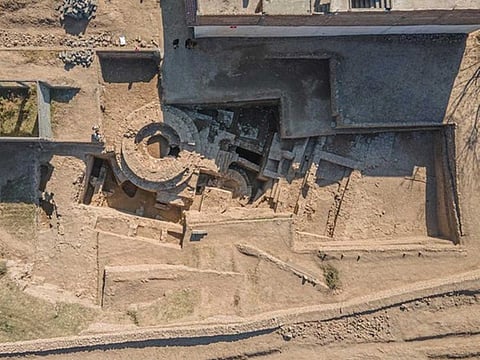Pakistan Buddhist temple among ‘Top 10 Discoveries of 2022’
Ancient Buddhist structure found in Barikot is roughly 2,200 years old

Islamabad: One of the world’s oldest Buddhist temples discovered last year in Pakistan has been featured in the ‘Top 10 Discoveries of 2022’ by the renowned Archaeology Magazine.
The temple was uncovered in the town of Barikot in the Swat region of Pakistan’s northwestern Khyber Pakhtunkhwa (KP) province. The rich cultural heritage of Swat attracts many foreign tourists and heritage lovers.
Archaeologist professor Luca Maria Olivieri of Ca’ Foscari University of Venice led the excavation which was conducted in collaboration with the International Association for Mediterranean and Oriental Studies (ISMEO) and the Directorate of Archaeology and Museums KP Province (DOAM KP) and the Swat Museum.
The structure dates back to the second half of the 2nd century BC or some 2,200 years ago. The site could be even older but only Carbon-14 dating analyses can confirm, according to the official statement. “This discovery sheds new light onto the forms of ancient Buddhism and its spread in old Gandhara, adding a piece to the puzzle of what we know about the ancient city” of Barikot.
The other nine top discoveries of 2022 are from Jordan, Egypt, Iraq, Mexico, Austria, Russia, Guatemala, Peru and Antarctica.
Top discovery of 2022
In its Top 10 Discoveries of 2022 feature, Archaeology Magazine featured the old temple, saying that the monument dated back to at least as early as the end of the second century BC. “This makes it the oldest known Buddhist temple in the region and places its construction firmly during the period when Barikot is known to have been a centre of Buddhist teaching and a sacred pilgrimage site.”
This region in northwestern Pakistan, known as Greater Gandhara, was “a crossroads for the exchange of goods and culture among the civilisations of the Middle East, Central Asia and India” from the sixth century BC.
Fascinating finds
During the 2021 excavation, the archaeologists unveiled a fascinating Buddhist monument. The temple’s ruins stand around ten feet tall and consisted of a ceremonial platform that once housed a stupa or dome often found in Buddhist architecture. The structure included a smaller stupa at the front, a room or cell for monks, a podium or pillar, a staircase, vestibule rooms, and a public courtyard that overlooked a road.
“The discovery of a great religious monument created at the time of the Indo-Greek kingdom testifies that this was an important and ancient centre for cult and pilgrimage,” says Olivieri in the statement. “At that time, Swat already was a sacred land for Buddhism.”
In addition to the temple, the team unearthed pottery, coins, jewellery, statues, seals, terracotta objects, seals and other ancient artifacts. The temple was likely abandoned in the third century AD following an earthquake, according to experts.
“We are now beginning to realize that, in addition to its strategic importance,” Olivieri was quoted as saying “Barikot had its own importance for Buddhist communities.”
Besides a religious centre, “Gandhara was at the nexus of multiple major imperial expansions, including those of the Persian Achaemenid Empire, Alexander the Great, the Mauryan Empire of northern India, and Indo-Greeks from Bactria, or Central Asia, who were in power at the time the newly discovered temple was built” according to the Archaeology Magazine.
Pakistan’s cultural heritage
The oldest Buddhist monument in Pakistan is the largest complex of Dharmarajika stupa, locally known as Chir Tope, located about three kilometres from the Taxila Museum. The Dharmarajika complex covers almost the entire period of the history of Buddhism in Taxila from the 3rd century BC to the 7th century CE, according to Taxila Museum.
“Pakistan is one of the most ancient lands and has been home to many cultures and civilizations” but its fascinating history and heritage remain less celebrated and little known. Dr Abdul Ghafoor, an archaeologist and director of Islamabad Museum, says “Awareness programmes such as educational trips are needed to increase awareness about local heritage buildings to encourage an interest in conservation and bring the public closer to past heritage.” Pakistani archaeologists say they can do a lot better with funds and support from the government to “present the country’s glorious past to the world”.
Sign up for the Daily Briefing
Get the latest news and updates straight to your inbox


